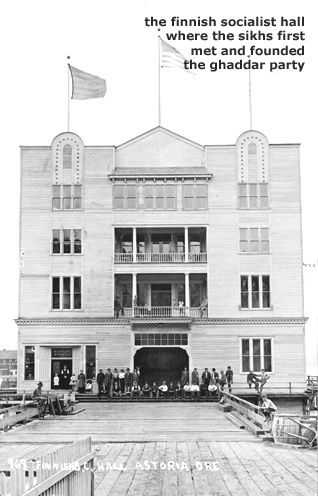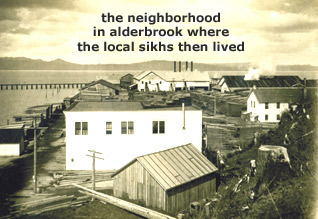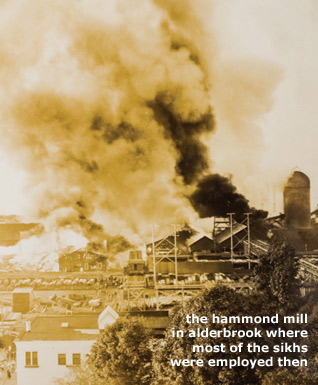
The Dhillon Family lived in Alderbrook in the early 20th Century. The youngest in this photograph, Kartar Kaur, revisited Astoria with her granddaughter Erika Andersen before the latter's 2000 film "Turbans" was released.



History
Roots of Freedom & Independence:
Sikh-Americans of Astoria, Oregon
CHELSEA GORROW
It was 1913 when a group on Sikh-Americans in Astoria, working in Alderbrook and along the Columbia River (in Oregon, USA) had an idea.
Sparked by the history of the American Revolution, a group of inspired immigrants who were not treated equally at home or in America, held a meeting at the Finnish Socialist Hall, where the Dunes Motel on Marine Drive now sits.
It was there that the group founded the Ghaddar political party, eventually leading to the freedom on the subcontinent from British rule. And on the 100th anniversary of the party’s creation – a party that no longer exists – Astoria will be celebrated as the birthplace of “the shot heard around the world.”
“Hundreds went back to India with the idea, with this party,” Astoria City Councilwoman Karen Mellin said. “They were a real threat to British rule so they were arrested, tortured, murdered, massacred. But that party was the first shot that was heard around the world. They identified with the American Revolution and what they learned here was a sense of freedom. They learned that if America could have a revolution against the British, that the Indians could do the same thing.”
A celebration of the political party’s founding – at first thought to be created in San Fransisco but since corrected – is in the works to be held the first week of October. Mellin hopes it will be a big success and that the Sikh-Americans will become part of Heritage Square eventually, joining the lot where the Garden of Surging Waves is currently under construction.
The garden is a tribute to the Chinese who assisted in creating Astoria as we know it, but were treated as less than equal. In many ways, that was also true for those from the subcontinent.
The week of events, Mellin said, a collaboration between the city, historians and Sikh-Americans, will be once again heard around the world, as Sikhs, Indians and Pakistanis across the globe celebrate the Ghaddar centennial.
An Air National Guard flyover is planned. A proclamation for the Ghaddar recognition was read at the March 18 Astoria City Council meeting.
SIKHS IN ASTORIA
Like the Chinese who came to work in Astoria during the early years of the city’s establishment, Sikhs also came, fleeing their homeland that was under British rule and experiencing a drought and a “plague of some sort,” Mellin said.
Often misclassified as Hindus once in Astoria, the Sikhs had fled first to Canada and then trickled down the coast looking for work. Most were Sikhs.
The Columbia River provided many opportunities and at one time there were more than 400 Sikhs in Astoria alone, according to a Kartar Kaur Dhillon article in a Cumtux publication.
“They came here I think in 1905 and they were all up and down the Columbia River as far as Bonneville,” Mellin said. “They booked passage to Canada but even though the Sikhs were also part of the British empire – and if you belonged to the British Empire under the conditions at the time you could live anywhere – they were discriminated against because they were low-wage earners. There was competition for work at that time, and the discrimination was pretty horrible against them in Canada. ... They were brown so they couldn’t be citizens.”
Sikhs eventually moved down to Bellingham, Washington from Canada, and worked their way towards the Columbia River, until many settled in Astoria.
The neighborhoods where they lived in Alderbrook became known by the disparaging and erroneous term, “Hindu Alley.”
“The Sikhs were living in Alderbrook alongside the Finns,” Mellin said. “They were working alongside the Finns. This is at a time when the IWW (Industrial Workers of the World) were really active. Wages were very low, working conditions were dangerous at best, but somehow in Alderbrook they all had a comradery there because the Finns and the Chinese and the Sikhs were all kind of classified in the same socioeconomic level.”
Most of the Sikhs worked at the Hammond Mill, located on Tongue Point. Their time in Astoria, however, was short-lived. When the mill burned down in 1922, the Sikhs left the area, too.
“That was it,” Mellin said. “They didn’t stick around long after that.”
But one family left their mark on the city.
They were the Dhillon family – two parents, four children, and three friends.
The youngest child, Kartar Kaur Dhillon, came back to Astoria in the 1990s with her granddaughter and documentary filmmaker Erica Andersen.
Andersen made a film about the Sikhs in the Northwest, titled “Turbans.” Mellin hopes the film will be brought back to Astoria for the October celebration.
But Andersen’s movie was just the start of the focus on the Sikhs in the Northwest and the birthplace of Ghaddar.
‘UNUSUAL REQUEST’
“All of this started with a letter to Mayor Van Dusen,” Mellin said. “Feb. 22, 2013, it says, ‘As mayor, chances are, you get your share of unusual requests.’ The letter writer said she would like to ‘add another one, but I hope you might find this one interesting enough to pursue further.’”
The letter was written by Johanna Ogden, who wrote an article, Ghaddar, Historical Silences, and Notions of Belonging in the Summer 2013 Oregon Historical Quarterly. She used the help of Liisa Penner at the Clatsop County Historical Society for much of her information and credits her in the article. Penner is Mellin’s sister.
“This would have never happened if Liisa Penner hadn’t (helped),” Mellin said. “I feel very privileged to have grown up listening to history with my sister.”
In Ogden’s article, she writes that the Daily Budget printed a notice on May 30, 1913, announcing an invitation to hear Har Dyal, a Stanford professor and “noted philosopher and revolutionist in India.” Har Dyal delivered a lecture on India. His presentation sparked the founding of the Ghaddar party, a revolutionary nationalist party that was “an uncompromising and radical new direction for Indian nationalist politics.”
“The Punjabis here, not all Sikhs, formed the party Ghaddar. It sounds like ‘gudder,’” Mellin said. “They felt welcome enough to be able to use the Finnish Hall and they formed this party. Ghaddar means revolution or mutiny. And after that, many of them had gone down to California and the party spread. It was formally thought it was formed in 1913 in San Fransisco but the research shows that no, it started in Astoria and then went to San Fransisco.”
When the mill burned down, some of the former Astoria residents returned to Punjab and India to fight for their freedom under the party. Other Sikhs in the U.S. went back as well. They were treated like terrorists, Mellin says, and captured, tortured or killed.
But though the party died, the idea lived on. India and Pakistan celebrated its freedom in 1947 after Winston Churchill was thrown out of power.
The Ghaddar party formerly dissolved in 1948.
[Courtesy: The Daily Astorian. Edited for sikhchic.com]
March 28, 2013


